|
FAQs about the Diagnosing Diseases of
Clownfishes
Related FAQs: Clownfish Disease 1, Diseases of Clownfishes 2, Diseases of Clownfishes 3, Clownfish Disease 4, Clownfish Disease 5, Clownfish Disease 6, Clownfish Disease 7, Clownfish Disease 8, Clownfish Disease 9, Clownfish Disease 10, Clownfish Disease 11, Clownfish Disease 12, Clownfish Disease 13, Clownfish Disease 14, Clownfish Disease 15, Clownfish Disease 16, Clownfish Disease 17, Clownfish Disease 18, Clownfish Disease 19, Clownfish Disease 20, Clownfish Disease 21, Clownfish Disease 22, & FAQs on
Clownfish Disease By: Environmental
Stress, Nutrition, Social/Behavioral/Territoriality, Trauma/Mechanical Injury, & Pathogens:
Lymphocystis, Infectious Disease (Bacteria, Fungi...),
Protozoans: Cryptocaryon/Ich,
Amyloodinium/Velvet, Brooklynella (see article below), &
Mysteries/Anomalous Losses, Cure, Success Stories, & Clownfishes in General, Clownfish Identification, Clownfish Selection, Clownfish Compatibility, Clownfish Behavior, Clownfish Systems, Clownfish Feeding, Clownfishes and
Anemones, Breeding Clowns,
Related Articles: Clownfish Disease, Clownfishes, Maroon
Clowns, Marine Disease,
Brooklynellosis,
|
|
|
Ulcer? 4/27/20
Good evening.
<Hey Hector>
I asked my friend about an ulcerative lesion on my clown’s jaw, and he told
me to email you.
Here it goes.
Just noticed it today. It’s not eating because the mouth is constantly open.
I plan on quarantining, but don’t know what meds I should try.
<Mmm; unfortunately there is no treatment for such a situation (that I'm
aware of); on the plus side, having seen and read re similar circumstances I
don't consider that this condition is "catching"... that is, it won't spread
to other livestock>
Thank you for your time.
Best regards,
Hector
<Were it my fish, I'd keep it as long as it doesn't seem to be suffering.
Otherwise, please see Neale's piece here on euthanasia:
http://www.wetwebmedia.com/euthanasia.htm
Bob Fenner>
|
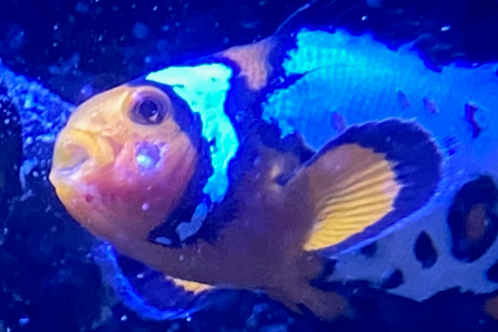 |
|
Re: Ulcer? 4/27/20
Thanks for your prompt response.
Hector
<Certainly welcome. BobF>
|
|
Ocellaris with black / dark patches 11/21/19
<Hi Eduardo, could you please crop, resize down your pix to just a few megs
and resend them?... otherwise you will crash our server. Cheers. Wil.>
Re: Ocellaris with black / dark patches 11/21/19
Hello Will, thanks for your response.
<Most welcome>
I'll answer your questions directly on the body of the email. Cheers. Ed.
Well, I've been in the hobby for quite some time and even though I've seen a
lot I came across something I'm uncertain about.
<Let’s see>
The male of ocellaris pair is showing some dark brown / black patches in the
lower part of his body going from the middle back to its tail, and uncertain
to what it is.
<Do these patches appeared suddenly?>
<<Yes they seem to have appeared suddenly>>
<Ok>
My pair have hosted some sort of olive/brown Palythoas for over 2 years.
I've seen the female and male with stung marks before but they are always
dark dots and not blotches.
<Maybe it was stung by another coral>
<<It could've been the new frog>>
<Yes>
I haven't checked my param.s, this week, but I keep them at ~400Ca, 1300+Mg,
7.7+Kh, will check my phosphates as I did have a power outage today that
lasted 5hrs (kept an air pump running the whole time), Nitrates <10ppm.
I will check them tomorrow again to see if anything is off, even with the
power outage I doubt it as all the corals and inverts are doing fine.
<How about the other readings...ammonia, nitrites, ph, specific gravity,
temperature?>
<<Haven't check ammonia, nitrite or ph for a while. SG is 1.025. I did have
a power outage that lasted for 5 hrs and I placed an air pump through the
whole time, temperature dropped to 24.6 but I keep it from 24.5 to 25.7 also
used a Biodigest vial and stop ammo vial after the power outage>>
<Mmm... am not a fan of additives, more of the idea of doing partial water
changes to dilute accumulated wastes, after power outages.>
I do keep softies like Zoas, Palys and mush, LPS Trumpets, Frog and hammers,
and SPS a few Acros , Montis chalices and such.
<These can irritate the clown’s skin specially in small / crowded quarters;
what is the size of your system?>
<<Is well over a 75g + 30 gal sump plus the frog is almost a foot to the
left and half a foot to the top away from where they stay in their Palys (It
does have 1 green Paly that recently got mixed with the olive ones)>>
Aside from the ocellaris, I also have a Cleaner Wrasse and a Mandarin fish
on that system, as well as a Cleaner shrimp, few hermits and snails.
The mandarin, wrasse and cleaner shrimp were added a few months ago and they
are all eating and acting normal. My last addition was a frog that i got
from a friend yesterday, he's reef is over 6 years old with a pair of
ocellaris that have almost 10 years (from a previous reef) and I only dipped
it in Revive and Lugol. It's doing fine right now. All my fish seem to be
acting normal, I did notice the wrasse a bit awkward, however eating
regularly, but I will need to confirm it. The female is showing a some dark
patches but much less than the male.
<I suspect the recently added Euphyllia may have to do with this>
<<Could be, but if it is far away should I worry about it going closer to
the frog?>>
<We can’t be 100% sure it will not.>
I'm attaching a few pics of my ocellaris, I'd appreciate if you could share
some info, or if you have come across something like this before. I will
pull the ocellaris out the tank it gets worse, but right now I'm only
observing as he is eating and swimming well, although he does seem to be
swimming in the current and opening up his mouth widely from time to time, I
know this symptoms resemble velvet, and I do have a Hospital Tank with
copper for about a month (covered with plastic to prevent aerosol
transmission) next to it and a QT tank on one side but I doubt it is velvet
or it would have already taken on the fish very fast and the patches doesn't
resemble velvet. One Idea that has come to my mind is predatory dinos after
the power outage. Thanks before hand, any help will be appreciate it.
<This appears to be "Hyper- Melanization" which is caused by stinging
organisms like the ones you have, I’d see if the blotches disseminate to the
rest of the clown’s body or if they fade away over the course of a few days,
if not, you’ll need to remove the offending life form, this can be difficult
to identify as it may be stinging the clownfish at night if/when the fish
swims nearby and touches it... again, I suspect of the Frogspawn.>
<<Very well, I'll keep an eye for any changes, the patches seemed to be not
spreading so that is good, and the clownfish is acting normal. Thanks again
for your help Will>>
<Please keep us posted. Wil.>
|
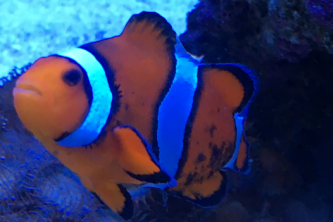 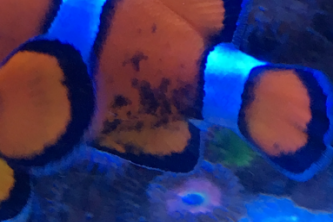 |
|
Top Fin Damage 11/15/19
Hello,
<Hey Nick>
Here are a couple pictures of my Amphiprion Ocellaris Clown. Three weeks ago I
noticed the top fin was looking white and he would rarely extend it. I've been
monitoring it and it didn't look like it was getting any worse till yesterday.
The white area looks like it's at the top of the body now.
He lived in a 55 gal tank for 5 years, and earlier this year I moved everything
into a 75 gal. The tank is stable. I haven't lost any fish in five years. I've
introduced a few corals (dipped) and some snails over the last few months. Fish:
2 clowns, 1 Royal Gramma, 2 Blue Chromis which are smaller than the clowns. The
Clowns sleep in a frogspawn. Sometimes the Royal Gramma will nip at the clowns,
but not enough to even make them swim away. Two small hermit crabs. He acts
healthy and normal, eats well.
Does this look like physical damage that needs time to heal? Is it more likely a
disease of some kind? What remedy should I employ?
I appreciate your advice!
<Does look like physical damage, this kind of wound is typically caused
by a nipping tank mate, watch carefully to identify the bully and isolate it.
This wound should heal in a few weeks.>
Thanks, Nick
<Welcome. Wil.>
|
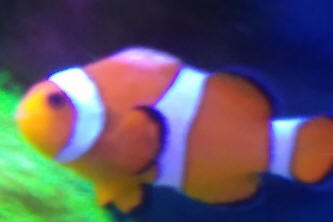 .jpg) |
Clownfish Hyperventilating 9/22/19
Good Morning, this morning I woke up to my clownfish on the bottom of the tank
hyperventilating as soon as it saw me he tried swimming up. It’s been an hour
and he is still fighting whatever it is off he maintains itself upright. I
checked my perimeters <parameters likely> and they’re fine I’m lowering my
salinity little by little I’m not sure it yesterday I saw stringy poop or not so
I’m not sure if he’s sick with parasites or just sick. I have had the tank for 4
months and the clownfish for 3 months he was doing just fine until today. I need
help please!
<When, where in doubt, water changes! I'd switch out a quarter or so of the tank
water, via gravel vacuuming... Stat! Unless you have another established,
suitable system to move the fish to. Bob Fenner>
What happened? Myst. Clown Loss 5/9/17
Hi WWM Crew,
<Eddie>
I told myself last time that I wasn’t going to email with any more questions for
a while, but I truly am puzzled by what happened this weekend, so here I am
again. It was time to add the first fish to my system. I set the system up at
the end of February, and I put in the live rock the first week of March. Then
Saturday I went and got my first fish—a clownfish (Amphiprion ocellaris). I also
got a cleaner shrimp (Lysmata amboinensis). I brought them home and acclimated
them as usual: I float the bags in the tank they are going into for 15 to 30
minutes, then I slowly add a little tank water to the bag, and pour out a little
water from the bag into a bucket until the ph, temp, and Spg are the same, then
I release the animal into the tank. This took a couple of hours. In this case I
put the clown and the shrimp directly into the DT. I didn’t quarantine the clown
because he was to be the first fish in the tank. I figured if he had a problem I
could catch him for treatment. I didn’t expect to have problems because he was a
tank bred clown, and I have kept them before without issue.
He seemed OK during the acclimation and when I first put him in the tank he swam
behind some of the live rock where he remained for the rest of the evening. I
had the light out, so I couldn’t see him well but he was swimming in the current
back there—kind of swimming in place with that “waggle” that clownfish do. The
next morning when I got up and checked on him, he was sitting in the sand
upright, but not swimming. He had found a place against the glass where the
current wasn’t as strong and was just sitting there. This concerned me, but not
terribly because I thought he might have selected this spot to sleep in—I’ve had
tank bred clowns before that have slept in weird places. I had one that would
sleep at the surface of the tank, up in a corner, just floating there on his
side—he did that for several years. But when I looked more closely at this fish
I noticed that he was breathing really hard. I’ve never seen a fish pump his
gills that fast. I couldn’t do anything with him at this point because I had to
leave. When I got back several hours later he was dead. He died sometime between
13 and 16 hours after I put him in the tank.
<Mmm>
My first guess was that something was wrong with the water, but the shrimp was
fine (and still as), as was everything else in the tank: two turbo snails, three
blue leg hermit crabs, lots and lots of little snails and starfish from the live
rock, and a Kenya tree coral that hitchhiked in on the liverock. All my water
tests came up normal (see below). Do you have any ideas what could have killed
this fish?
<Only guesses. Might well be this one fish had some sort of trauma, predisposing
genetic issue...>
Is there a problem you can have with your water that would kill a fish that
fast, but not inverts?
<There are several possibilities here; yes>
Could it have been “clownfish disease” with a tank raised clown?
<Doubtful... perhaps it ate an organism that didn't "agree with it". Happens>
Could it have been the acclimation?
<Did you measure ammonia in the shipping water? See WWM re Guerilla Acclimation
(techniques); rarely issues w/ locally purchased, transported livestock though>
I live an hour and a half away from the LFS, so he was in the bag for three or
four hours total counting travel time and acclimation. I put the bag in an
insulated container for the trip home. This was never a problem before when I
got fish for my old system several years ago. I thought of one other
possibility. I had made a new Durso standpipe for the tank. The bulkhead is a
slip bulkhead and the one I had kept slipping out every now and then due to the
current from the circulation pumps. Anyway, I had made it with pvc cement the
day before.
<Actually; there is no such thing as PVC "cement"; the process involves a
solvent... Nothing left between the pipe, fittings... and a day is long enough
to cure>
I gave it more than 32 hours to dry and rinsed it thoroughly with water. While
the fish were acclimating, I installed it in the tank. Could there have been
something left over from the PVC cement that harmed this fish? It would have to
be something that didn’t harm the inverts.
<Agreed; and not this>
Anyway, while I am devastated to lose this fish, my biggest concern is for the
next fish that I get. If this was just one of those anomaly loses that sometimes
happens, that’s fine, but if it is something wrong with my water, I need to fix
it.
<I would "chalk the loss up" to the former and try another specimen m'self>
Water test and tank information:
· 75 gallon tank, 30 gallon sump (90 to 95 gallons of water)
· 42 lb. live rock and 35 lb. of previously live rock
· Spg: between 1.024 and 1.025
· Ph: 8.1
· dH: 10
· Am: 0
· Nitrite: 0
· Nitrate: 0 (live rock is handling this thus far)
· Calcium: 400
· Temperature 78
Thanks for your patient help with me as I re-venture into this world again. I
know I have bothered you all too often, but you have always patiently helped.
Thank you.
Eddie
<Never a bother. Thank you for writing Eddie. Bob Fenner>
Re: What happened? 5/9/17
Hi Bob,
<Hey Eddie>
Thanks for the lightening fast reply. I did check the ammonia in the shipping
bags, but I forgot at first. I had mixed in a little bit of system water before
I thought to do that. It was fairly early on though. It came out zero.
<Ahh; well; worth asking... Might be that a sudden shift in pH led to too much
stress through "ammonia burn">
I don't think this was it. It was only a couple of hours before I started mixing
the water in. Also I requested a bigger bag with more water in it because I had
so far to travel.
<Ah, good>
I always tried to do this when getting fish in the past. Anyway, I will try
again in a few weeks.
<Is what I would do too>
I was curious. You said that there are several possibilities for what could kill
a fish that fast but not inverts. I know disease might be one. What are the
others?
<Nitrogenous issues, low dissolved oxygen; thermal shock... There are several
more. Bob Fenner>
Re: What happened? Myst. Clownfish loss
5/12/17
Hi Bob,
<Hey Eddie>
I’ve been thinking about your reply for a couple of days ago, especially the
possibility of low dissolved oxygen.
<A very common issue with aquariums, particularly marine tropical>
I don’t think that is what killed this fish, because he was the only one in
there, but I do have a lot of confusion about dissolved oxygen and carbon
dioxide and how it relates to ph and possibly temperature. I am concerned that I
am not getting enough oxygen (or getting rid of enough carbon dioxide) to handle
the eventual fish load that I will have in the tank—or I may just be confused.
<Can have too little O2 and/or too much CO2... the higher temp., less solubility
and higher metabolism... In general, higher DO, higher pH, and the reverse for
CO2, carbonic acid in solution>
Back in 2012, when I had my old tank, I had a very enlightening conversation
with you about Ph that resulted in my reading all the Ph FAQs and learning a
lot. In that tank I had high Nitrates (that I was blissful unaware of) holding
the Ph down around 8.1. I came to understand that Ph is affected by the amount
dKH, the amount of calcium and magnesium, the amount of nitrates, and also the
amount of oxygen verses carbon dioxide. I know it’s way too simplistic, but how
I kept it straight in my mind is that if you had dKH between 8 and 12, Calcium
around 400 and magnesium in proportion, low Nitrates, and enough DO that your pH
ought to come out around 8.3 or so. I realize, of course, that I may still be
missing something.
<Mmm; you have a good grasp of the essential factors>
So now fast forward to my new tank. Ever since I set the tank up I’ve been
trying to figure out why my PH stays around 8.0. Over the last 2 ½ months it has
fluctuated from 7.9 to 8.1 (using two separate test kits—one brand new one). I
have a dKH of 10 to 11 all the time. My Calcium has been at 400 or slightly
higher. I don’t have any Nitrates yet (the live rock is taking care of them so
far). The only thing in the tank during this time has been the live rock (and
everything that came in with it), two snails and three blue leg hermit crabs
that I put in the first week of April, and the cleaner shrimp that I put in with
the fish on Saturday. So I concluded that I either wasn’t getting enough oxygen
or getting rid of enough Carbon dioxide to get the Ph any higher. I proved this
to myself the other night by taking a cup of tank water and aerating it for
about 3 hours with a small air pump/stone. The PH was 8.2 or 3 when I was
finished.
<Ahh!>
I was hoping to run my set up and some of the things I’ve tried by you to see if
I am missing something. So here goes . . .
It is a 75 gallon tank, 30 gallon sump (90 to 95 gallons total) with a >1” sand
bed 42lb of live rock and 35lb. of formerly live rock from the old tank. In the
sump I have an Aqua C EV 180 skimmer running on a Mag 7. My return pump is a Mag
7. I have plumbed two pvc returns over the back—each with locline at the end.
Initially I was getting around 325 to 335 total gph (after head loss). The
loclines are positioned so that the return water breaks the surface some as it
comes into the tank. In the tank I have twin circulation pumps run by a
Wavemaker. The flow rate is adjustable from 175 to 2000 gph each. I have
experimented with them several different ways. Right now I have them on opposite
ends of the tank about four inches from the top set two notches below full blast
with fairly short intervals. They are both pointed somewhat toward the surface
and I have a fair amount of turbulence.
<Good>
Much more and I would be nervous about it sloshing out. In fact this is why I
had to make the new standpipe. The turbulence kept shaking the old one loose. I
had them on full blast for a while, but a little lower in the tank and not
pointed upward (again because I didn’t want any water sloshing out).
I have two drains with Durso standpipes—an inch drain and a ¾ inch drain
(converted return on the 75 AGA). Both drop straight into the sump. The 30
gallon sump has three main sections. The first holds the skimmer (on a stand),
the skimmer pump, and the heater. This section has all kinds of surface
agitation/bubbles between the two drains and the skimmer return. Then, after a
set of baffles with a bubble trap is the refugium. I was originally going to
have a DSB in here, but I got too nervous because the sump was a used tank and I
didn’t want to push it. I have less than an inch of sand in it now and am going
to add a little crushed coral and live rock rubble and some small pieces of live
rock to raise pods. I’m also going to add some macro algae to it when I find a
store that carries it. I have a LED 15w Lights of America grow light suspended
over it. For the last week I have been doing a reverse daylight lighting program
with it. The last section of the sump holds the return pump.
Here are some things I have tried . . . I played around with the circulation
pumps, but it didn’t make much difference. Opening the skimmer drain all the way
seemed to help a little (I got a lot more turbulence in that part of the sump),
but it also slowed down the skimmer production some (not that I’m getting a lot
with a new tank without any fish anyway). I added an airstone with an air pump
to the sump. I’ve tried several air pumps actually, and have the most powerful
one that I have on it now. It was originally rated for 60 gallons, but it is old
and may not be getting quite that much. None of this seemed to help much. I
began to wonder if the problem is not aeration, but the inability of the carbon
dioxide to escape.
Since setting the tank up I had glass panels on the top of the DT in the front
half.
<This I was going to mention>
The back was open. I removed these the other day, but it didn’t help much (I
intend to probably leave these off and make some lids for the front and back out
of fiberglass window screen with eggcrate frames). This did help a little bit
with my heat problem. I had had a hard time with the tank getting up above 79
degrees in the afternoon (I had it set on 78). I was concerned about this with
summer coming on. Taking this glass off has helped with that. I have been able
gradually to bring the temp down to the 77 range. I know decreasing temperature
helps with capacity to hold oxygen. Does that mean that lower temperature would
increase PH?
<To some extent; yes>
I think though that if there is a problem with not enough Carbon Dioxide
out-gassing it is because of my stand cabinet arrangement. The stand is
homemade. It is a frame made out of 2x4’s and 2x6’s with 1/4” Oak panels on the
sides and doors on the front. The back (against the wall) is open. There is
about a 1 1/2” gap between the stand and the wall where air can enter the inside
of the cabinet. This is because I used a 2x4 as a mounting board between the
stand and wall to leave room for my over the back return plumbing. When the
cabinet doors are closed, this is the only way air can get in and out.
<Can you cut out some part of the door panels and insert some screening?>
Of course, most of my best aeration devices (the skimmer and the air pump) are
inside the cabinet. One other thing that I did is I put a sheet of glass (23” x
9.5”) along the back of the sump as a shield for splashing from the drains &
skimmer return. It is resting on the back lip of the sump, vertical on the long
side, leaning against the drain tubes. Point is it blocks a good bit of the
ventilation area at the back of the cabinet, but certainly not all of it. I’ve
tried leaving the cabinet doors open overnight, and it seems to help a
little—but I can’t leave them open all the time due to the noise of the pumps.
<May be time to trade these in...>
So I’m wondering if maybe the inside of the stand does not have enough access to
good oxygen to get it into the water. My next step is going to be to remove the
glass panel, but what after that? Should I put the air pump outside the cabinet?
<Worth trying>
Should I run some vinyl tubing from the skimmer’s air intake that goes out the
back of the cabinet to fresher air? Would that mess up the skimmer’s
performance?
<Worth trying again, and no>
Should I try a powerhead in the sump with a venturi tube running outside the
stand? Do I need more algae growth in the system?
<Or an RDP lighting arrangement...>
I plan to get a dissolved oxygen test at some point, before I get too many fish,
just to set my mind at ease. But if it tells me what I expect, how can I improve
this situation. I thought setting this up that having a big protein skimmer
would handle getting plenty of oxygen in the tank. That’s why I’m confused. I
know I’m missing something here, but what?
I apologize for the length of this email. I didn’t intend to write such a
lengthy discourse, but I wanted to describe the set up and everything I’ve
tried. Thank you for your patience and all your help. Mere words are not enough
to express my gratitude to you. Oh, and I hope you are having a great dive trip.
I can’t wait to see the pictures!
Eddie
<Am just out on the Big Island... in the water tomorrow. Cheers Eddie. BobF>
|
Disease Identification: Black Clownfish
1/26/16
Hello, I recently noticed one of my black Clownfish has what appears something
developing on its face. I've included a photo.
<Yikes...>
It appears to be discolored and a portion of it is raised. I have a concern it
is a fungus or a parasite. Are you able to discern what it is from the image?
What would your recommend?
<Mmm; well; this might be Uronema; other protozoan... or... I'd be sampling and
looking under a microscope ahead of trying actual treatment/s. Bob Fenner>
Thanks so much for your insight.
Brent Wells
|
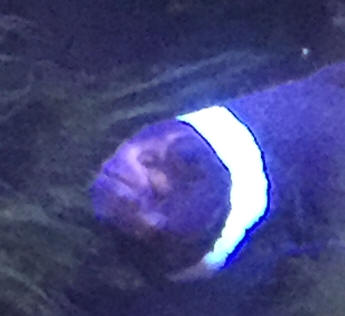 |
|
Re: Disease Identification: Black Clownfish
1/27/16
Bob,
When you say looking under a microscope, how does an average Joe like me get
that done?
<I do it... not hard to do; nor expensive... Let me refer you here:
http://www.wetwebmedia.com/microscopfaqs.htm >
Are there places I should look for in my area?
<For a 'scope? Likely the sites listed on the referral are fast... Or ask around
at your local fish stores. The better ones have their own; may well help you in
diagnosing>
I'll look closer into the possible things you suggested, I'm not sure if I treat
the tank or remove the fish to quarantine.
<I'd leave it where it is for now... Read. BobF>
Thanks,
Brent
|
|
|

